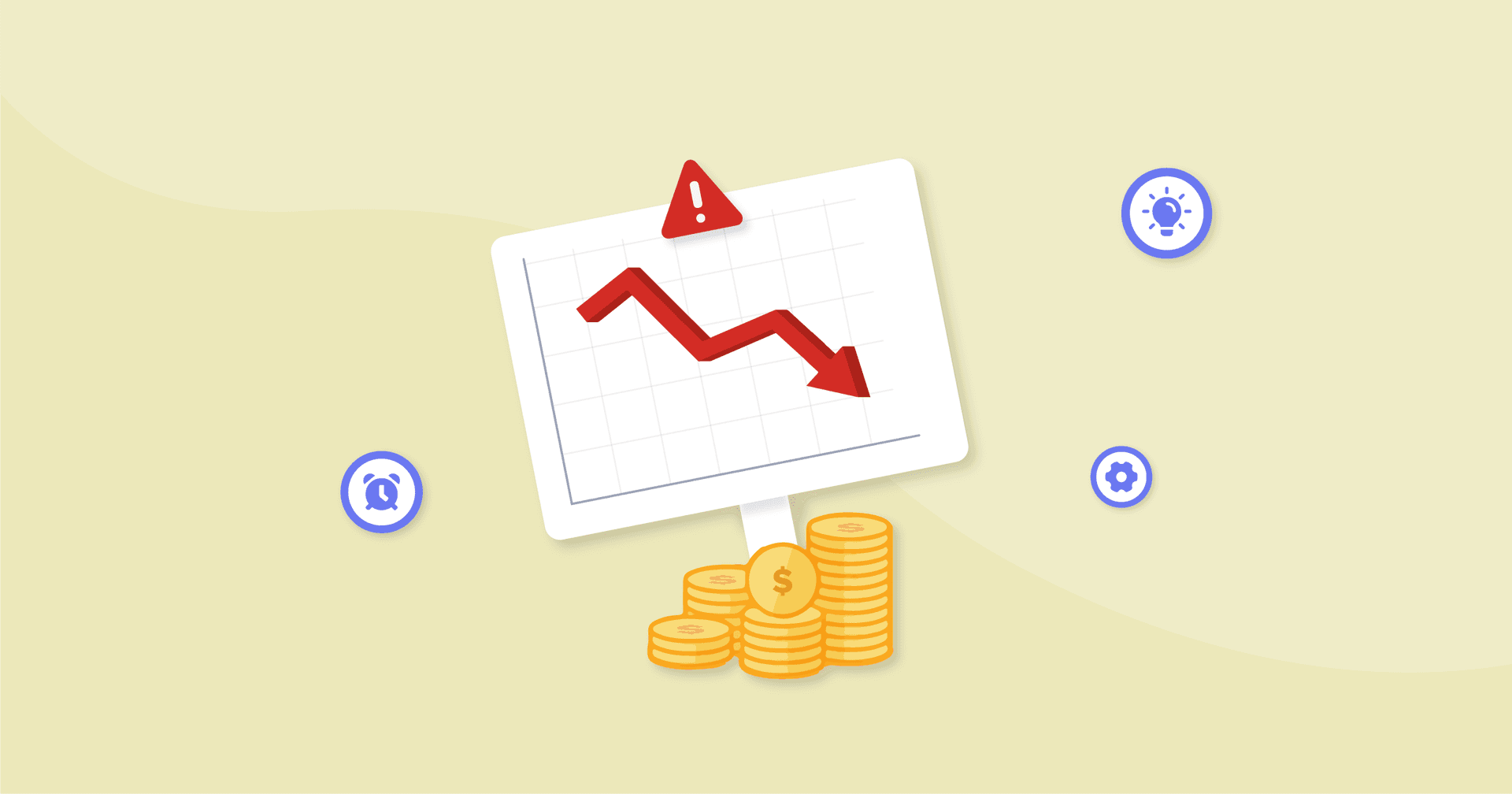Table of Contents
Table of Contents
- What is employee utilization rate?
- How to calculate employee utilization rate
- What’s the average utilization rate for agencies?
- Why utilization rate matters for agencies
- Tips to improve employee utilization rate
- Measuring and monitoring improvement
- Achieve your optimal billing rate without burning out your team
7,000+ agencies have ditched manual reports. You can too.
Free 14-Day TrialQUICK SUMMARY:
Calculating your employee utilization rate is key to understanding how to maximize your agency’s profitability. Know which tasks and projects take up the most time so you can maximize time spent on billable work instead of busy work.
When you’re running a marketing agency, your team is your most valuable asset, and understanding how you’re using that resource is vital. Your employee utilization rate reveals how effectively your agency is converting available work hours into billable revenue.
How much time does your team spend on strategic campaign work and client consultation compared to behind-the-scenes tasks like pulling data from multiple platforms, formatting spreadsheets, and preparing report presentations?
When you know how your team is spending their time, you make smarter decisions about project planning, resource allocation, and timelines, leading to higher employee satisfaction and better client outcomes.
In this guide, we'll uncover the benefits of tracking employee utilization, what it says about your team's productivity, and how it affects your agency's bottom line.
What is employee utilization rate?
Employee utilization rate measures the percentage of an employee's available work time that is spent on billable client work. It's the ratio between productive, revenue-generating hours and total available working hours.
For agencies, this metric is particularly important because it directly impacts profitability. Unlike product-based businesses, agencies sell time and expertise. The more efficiently you convert your team's hours into billable work, the healthier your bottom line becomes.
A high utilization rate indicates that your team is spending most of their time on revenue-generating activities, while a low employee utilization rate suggests significant time is being lost to non-billable tasks, inefficiencies, or administrative overhead.
How to calculate employee utilization rate
This is the basic utilization rate formula:
Employee Utilization Rate = (Billable Hours ÷ Total Available Hours) × 100
Let's break this down with a practical example:
Sarah, a senior account manager, works 40 hours per week. In a typical week, she spends:
28 hours on billable client work
6 hours in internal meetings
4 hours on administrative tasks
2 hours on professional development
Sarah's utilization rate would be: (28 ÷ 40) × 100 = 70%
For more comprehensive tracking, many agencies also calculate utilization rate like this:
Team Utilization Rate = (Total Team Billable Hours ÷ Total Team Available Hours) × 100
Monthly/Quarterly Utilization Rate to identify trends and seasonal patterns.
Agency Tip: For more tips on striking the right balance between boredom and burnout, check out our comprehensive guide to agency utilization rate.
What’s the average utilization rate for agencies?
Time-tracking is a must for accurately monitoring your agency's utilization rate. The utilization rate formula measures employee productivity by calculating the ratio of billable hours to total available work hours.
By tracking how many hours employees spend on client-facing tasks versus their total contracted hours, you determine what percentage of their time generates revenue for your agency.
So, with that in mind, what is a good employee utilization rate?
Most agencies aim for a utilization rate between 70-80%. An ideal utilization rate means that employees spend the majority of their time on billable client work while maintaining capacity for essential non-billable activities like professional development, internal collaboration, and strategic planning.
Even high-performing agencies don't maximize every hour for client work. Sustainable utilization rates make sure there’s time for the internal activities that drive long-term growth and employee satisfaction. Understanding your team's utilization rate helps you make informed decisions about capacity, hiring needs, and operational efficiency.
Agency tip: It takes around 23 minutes for team members to get back on track after being interrupted. Eliminate the "quick question" emails by giving clients access to custom marketing dashboards so they can check performance on their own time without interrupting your team when they’re in the zone.

Why utilization rate matters for agencies
For marketing agencies, time truly is money. Unlike businesses that sell physical products, agencies generate revenue by converting their team's expertise and hours into client results. This makes employee utilization rate one of the most critical metrics for agency success.
A strong utilization rate means your team spends more time on revenue-generating client work and less time on administrative overhead. This directly impacts your agency's profitability, competitive positioning, and ability to deliver exceptional client service.
When utilization rates are optimized, agencies offer competitive pricing while maintaining healthy margins, make informed hiring decisions, and ensure their most valuable resource–their people–are focused on what they do best.
Reclaim hours per week for every team member! AgencyAnalytics eliminates the platform juggling and manual data compilation that kills utilization rates. Try it free for 14 days.

Here are a few of the big benefits of optimizing employee utilization rate at your agency:
1. Instantly boost your bottom line
Higher utilization rates translate to higher revenue without increases in overhead costs. When your team spends more time on billable work, your agency generates more income from the same salary expenses.
2. Know what you’re working with
Understanding utilization rate helps agencies make informed decisions about hiring, workload distribution, and client capacity. It reveals whether you need to hire additional staff or if current resources are underutilized.
3. Price competitively while protecting margins
Agencies with higher utilization rates can offer more competitive pricing while maintaining healthy profit margins. This efficiency advantage can be a significant competitive differentiator.
4. Keep your best people happy
While it might seem counterintuitive, employees often prefer having meaningful, billable work rather than sitting idle or working on low-value administrative tasks. Optimal utilization rates contribute to job satisfaction and professional growth. Not only does measuring employee engagement alongside utilization rates maximize efficiency, it also contributes to team morale and job satisfaction.
5. Make revenue predictable
When utilization rates are higher, it becomes easier to predict your revenue, making cash flow management and business planning more reliable.
Hustle culture doesn't deliver anything except disengagement and burnout. When people feel valued and cared for, they naturally deliver their very best work. This culture can also help your agency grow, attracting top talent by showing people what you do to support your staff and that you truly respect their needs.
Michelle van Blerck, Communications Manager, Digital Freak
Tips to improve employee utilization rate
Improving utilization rates requires a strategic approach to eliminating time drains and optimizing workflows.
The most effective agencies focus on automating routine tasks, implementing proactive systems, and ensuring their teams spend time on high-value activities that directly contribute to client success.
Here are proven strategies to maximize your team's billable hours:
Automate reporting and data collection
The biggest drain on utilization rates is often the time spent gathering data from multiple platforms, creating charts, and formatting reports. Report automation and scheduling frees up hours of manual work each week, allowing your team to focus on strategic analysis and client consultation rather than data compilation.
Look for solutions that offer AI-powered summaries to identify key insights, trends, and challenges across client accounts. This transforms the reporting process from time-consuming data mining into strategic storytelling that adds real client value.
AgencyAnalytics' Ask AI feature identifies trends and opportunities so your team spends time on strategy instead of data mining. Start your free 14-day trial today!
Use time tracking tools
Time tracking software helps you understand exactly where hours are being spent. Look for solutions that integrate with your existing workflow rather than adding another platform to manage. This visibility helps identify utilization bottlenecks and opportunities for process improvement.
Combine project management with client reporting
Stop juggling separate tools for project management, time tracking, and client reporting. Smart project management software combines these functions, eliminating the productivity drain of constant tool-switching so teams can focus on the work you charge clients for instead of administrative coordination.
Implement proactive monitoring systems
Instead of having team members manually check campaign performance daily, use automated alerts and anomaly detection to notify your team only when attention is needed. This shifts your agency from reactive to proactive, allowing strategic work to continue uninterrupted while ensuring nothing important slips through the cracks.
Streamline client communication
Replace scattered email threads and ad-hoc status requests with centralized client messaging. When clients can access real-time updates and team members can collaborate within the same platform, you eliminate the constant context switching that fragments productive work time.
Create smart dashboards for real-time visibility
Interactive client dashboards that pull data from all client platforms give your team instant access to performance insights without manual data gathering. When information is readily available, team members spend more time interpreting results and developing strategies rather than hunting for data.
Implement strategic marketing resource management
Effective marketing resource management goes beyond doling out project assignments. Use integrated platforms that provide visibility into team capacity, skill sets, and project demands to optimize resource allocation and maximize billable hours across all client accounts.
Prioritize high-value work
Focus your team's billable hours on activities that directly impact client success: strategic planning, campaign optimization, and consultative guidance. Automate or eliminate low-value tasks that don't require human expertise or strategic thinking.
Our team is happier because they can work on high-level objectives and tasks. They’re able to achieve results for our clients rather than getting bogged down in the reporting. Showcasing this to clients helps us win them over in the beginning and quickly build trust in our abilities.
Calum Maxwell, Managing Director, Optimise Online
Measuring and monitoring improvement
Once you've implemented strategies to improve utilization rates, it's crucial to track progress and adjust your approach, just like you would for any client campaign.
Here are some ideas to make sure you’re on the right track:
1. Track utilization alongside other key metrics
Monitor utilization rate as part of your broader agency KPI dashboard. Track it alongside agency metrics and KPIs like profit per employee, project margin, and client satisfaction scores to get a complete picture of operational health and identify areas for improvement.
2. Role-specific analysis
Track utilization by role and seniority level to identify which positions or experience levels need additional support or process improvements.
3. Project-level insights
Analyze utilization by client or project type to understand which engagements are most efficient and which might need process improvements.
4. Before-and-after comparisons
When implementing new tools or processes, measure utilization rates before and after to quantify the impact of your improvements.
Agency tip: New to tracking agency performance? Start with the basics: what is a KPI? A Key Performance Indicator measures what matters most to your business success. While KPIs like client retention and profit margins tell you if your agency is healthy, utilization rate shows you if it's running efficiently. Put them all on one dashboard and you'll quickly see how better time management flows straight to your bottom line and pinpoint costly time-wasters.
Achieve your optimal billing rate without burning out your team
Employee utilization rate is like your agency's health check–it tells you whether you're running efficiently or burning out your team on busywork. When you reduce non-billable time spent on administrative tasks and automate these processes instead, your people get to focus on the strategic work they actually enjoy. That's how you build sustainable growth without burning anyone out.
Tracking utilization rates gives you a more accurate picture of your agency's operational health. Your team feels more engaged because they're doing meaningful work instead of wrestling with spreadsheets. Customer satisfaction improves because your experts are focused on strategy, not data entry. And your agency becomes more profitable and competitive by reducing resource costs and optimizing billing efficiency.
Why risk losing your best people to administrative burnout when project management software and smart capacity planning can solve these challenges automatically?
Agencies that treat their team's time as their most valuable asset are the ones that succeed long-term. It's not about squeezing every minute out of your employees, but making sure those minutes are spent on work that matters. When you optimize utilization rates thoughtfully, you're creating an environment where people can do their best work.
Ready to boost your organization's capacity utilization rate? AgencyAnalytics streamlines reporting, automates data collection, and eliminates time-wasting admin tasks so your people can focus on what they do best. Start optimizing today with a 14-day free trial.

Written by
Anya Leibovitch is a B2B SaaS content marketing specialist. She partners with tech companies to design and execute their content marketing strategy. A writer first and foremost, she harnesses the power of storytelling to build and strengthen relationships between companies and the clients they serve.
Read more posts by Anya LeibovitchSee how 7,000+ marketing agencies help clients win
Free 14-day trial. No credit card required.
